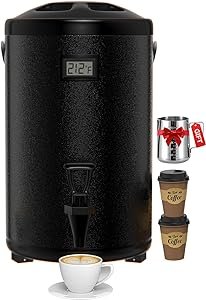Coffee lovers, are you ready to explore the fascinating world of coffee beans? Whether you’re new to the scene or a seasoned aficionado, understanding the different types of coffee beans is crucial for brewing that perfect cup. In this post, we’ll deep-dive into the various types of coffee beans, their unique characteristics, and how they influence your coffee experience.
Introduction to Coffee Beans
Coffee beans are the seeds of the Coffea plant, and they come in various species and varieties. The two most popular species are Coffea Arabica and Coffea Canephora (commonly known as Robusta). However, within these species are numerous varieties and cultivars that coffee farmers cultivate and coffee enthusiasts cherish. Let’s take a closer look at the primary types of coffee beans and what makes each unique.
Arabica Beans
What Are Arabica Beans?
Arabica beans, scientifically known as Coffea Arabica, are the most popular coffee beans in the world. They account for approximately 60-70% of the global coffee production. Known for their smooth, complex flavors and aromatic qualities, Arabica beans are often considered superior to other types.
Flavor Profile
Arabica beans offer a wide range of flavors, from sweet and fruity to nutty and chocolatey. These beans typically have higher acidity levels, which contribute to their bright and vibrant taste. The flavor can vary significantly depending on the growing region. For instance, Ethiopian Arabica beans are known for their fruity and floral notes, while Brazilian Arabica beans tend to have a nuttier, chocolatey flavor.
Growing Conditions
Arabica beans thrive in high altitudes and require specific growing conditions to flourish. They prefer temperatures between 60-70°F and need plenty of rainfall. These beans are primarily grown in Latin America, Africa, and parts of Asia. Because they are more delicate and susceptible to pests and diseases, Arabica beans are often more expensive than other types.
Robusta Beans
What Are Robusta Beans?
Robusta beans, or Coffea Canephora, are the second most popular type of coffee bean. They are known for their strong, bold flavor and higher caffeine content compared to Arabica beans. These beans make up around 30-40% of the global coffee production.
Flavor Profile
Robusta beans have a distinct, robust flavor that is often described as bitter, earthy, and woody. They have a lower acidity level but a higher caffeine content, which gives them a more pronounced bitterness. The intense flavor profile makes Robusta beans a popular choice for espresso blends and instant coffee.
Growing Conditions
Robusta beans are hardier and more resilient than Arabica beans. They can grow at lower altitudes and are more resistant to pests and diseases. These beans thrive in hotter climates with temperatures between 75-85°F. Major Robusta-producing countries include Vietnam, Brazil, and Indonesia.
Liberica Beans
What Are Liberica Beans?
Liberica beans (Coffea Liberica) are less common but have a unique flavor profile that sets them apart from Arabica and Robusta beans. These beans are grown primarily in the Philippines, Malaysia, and parts of West Africa.
Flavor Profile
Liberica beans have a distinct, bold flavor with strong smoky, woody, and floral notes. Some describe the taste as having hints of dark chocolate and ripe fruit. The unique flavor profile makes Liberica beans an acquired taste, often appreciated by those looking for something different in their coffee experience.
Growing Conditions
Liberica beans are grown at lower altitudes and can tolerate hotter climates. They are more resistant to pests and diseases, making them easier to cultivate. However, due to their limited production and niche market, Liberica beans can be harder to find and more expensive.
Excelsa Beans
What Are Excelsa Beans?
Excelsa beans, recently reclassified as a variety of Liberica, are grown mainly in Southeast Asia. Despite being a type of Liberica, Excelsa beans have distinct characteristics that set them apart.
Flavor Profile
Excelsa beans are known for their unique, fruity, and tart flavor profile. They offer a complex taste with hints of dark fruit, berries, and a touch of smokiness. The complex flavor makes Excelsa beans a popular choice for blending with other coffee types to enhance the overall taste.
Growing Conditions
Like Liberica, Excelsa beans grow at lower altitudes and can tolerate various climates. They are relatively hardy and resistant to pests and diseases. However, their limited cultivation and niche market make them less accessible than Arabica and Robusta beans.
Insulated Beverage Dispenser

- 2.2 Gallon
- 304 Stainless Steel
- Thermal Hot Beverage Dispenser 8 L
- Hot and Cold Drink Dispenser
- Spigot for Hot Water Coffee Chocolate Tea Cold Milk Cocoa
Specialty Varieties and Cultivars
What Are Specialty Varieties and Cultivars?
Within the main types of coffee beans, there are numerous specialty varieties and cultivars that offer unique flavors and characteristics. These varieties result from selective breeding, genetic mutations, and regional adaptations. Let’s explore some popular specialty coffee varieties.
Geisha (Gesha) Coffee
Geisha coffee, originally discovered in Ethiopia, is now famously grown in Panama and other regions. Known for its exceptional quality and floral, jasmine-like aroma, Geisha coffee is often considered one of the best in the world. It is highly sought after by coffee enthusiasts and can command premium prices.
Bourbon Coffee
Bourbon coffee is a variety of Arabica known for its sweet, complex flavor with hints of caramel and fruit. It is widely grown in Latin America and Africa and is prized for its rich and well-balanced taste.
Typica Coffee
Typica coffee, another variety of Arabica, is one of the oldest and most widely grown coffee plants. Known for its clean, sweet flavor with a touch of acidity, Typica coffee is a staple in many coffee-growing regions.
The Importance of Bean Quality
How to Identify High-Quality Beans
The quality of coffee beans can significantly impact the taste and overall coffee experience. High-quality beans are typically uniform in size, free from defects, and have a consistent roast. Look for beans with a fresh, vibrant aroma and avoid those with a stale or musty smell.
The Role of Freshness
Freshness is crucial when it comes to coffee beans. Freshly roasted beans retain more of their natural flavors and aromas. To ensure freshness, buy whole beans and grind them just before brewing. Store your beans in an airtight container away from light, heat, and moisture.
The Impact of Processing Methods
The way coffee beans are processed can also affect their flavor profile. Common processing methods include washed, natural, and honey processing. Each method brings out different characteristics in the beans, influencing the final taste of your coffee.
Exploring Coffee Regions
Latin America
Latin America is renowned for producing high-quality Arabica beans. Countries like Colombia, Brazil, and Costa Rica are famous for their coffee production. The region’s diverse climates and altitudes contribute to a wide range of flavor profiles, from bright and fruity to rich and chocolatey.
Africa
Africa is home to some of the world’s most distinctive and flavorful coffee beans. Ethiopian coffee is known for its fruity and floral notes, while Kenyan coffee offers bright acidity and complex flavors. Other notable producers include Tanzania and Rwanda.
Asia
Asia produces both Arabica and Robusta beans, with countries like Vietnam, Indonesia, and India leading the way. Vietnamese coffee is known for its strong, bold flavor, while Indonesian coffee often features earthy and spicy notes.
Brewing the Perfect Cup
Choosing the Right Brew Method
The brewing method you choose can significantly impact the flavor and strength of your coffee. Popular methods include drip brewing, French press, espresso, and pour-over. Experiment with different techniques to find the one that best suits your taste preferences.
Grinding Your Beans
The grind size of your coffee beans plays a crucial role in the brewing process. A coarse grind is ideal for methods like French press, while a fine grind is necessary for espresso. Adjust the grind size based on your brewing method to achieve the perfect extraction.
Water Quality and Temperature
Water quality and temperature are often overlooked but essential factors in brewing great coffee. Use filtered water to avoid any off-flavors, and aim for a water temperature between 195°F and 205°F for optimal extraction.
Conclusion
Exploring the world of coffee beans is an exciting journey that can significantly enhance your coffee experience. From the fruity notes of Ethiopian Arabica to the robust flavors of Vietnamese Robusta, each type of bean offers a unique and delightful taste. By understanding the different types of beans and their characteristics, you can make informed choices and elevate your daily brew.
FAQs
Q1. How many types of coffee beans are there?
A1. There are four main types of coffee beans: Arabica, Robusta, Liberica, and Excelsa.
Q2. What is the most popular type of coffee bean?
A2. Arabica beans are the most popular, accounting for 60-70% of global coffee production.
Q3. How can I identify high-quality coffee beans?
A3. Look for uniform, defect-free beans with a fresh, vibrant aroma. Avoid beans with a stale or musty smell.
Ready to explore more? Join our coffee community for exclusive tips and updates. Happy brewing!






